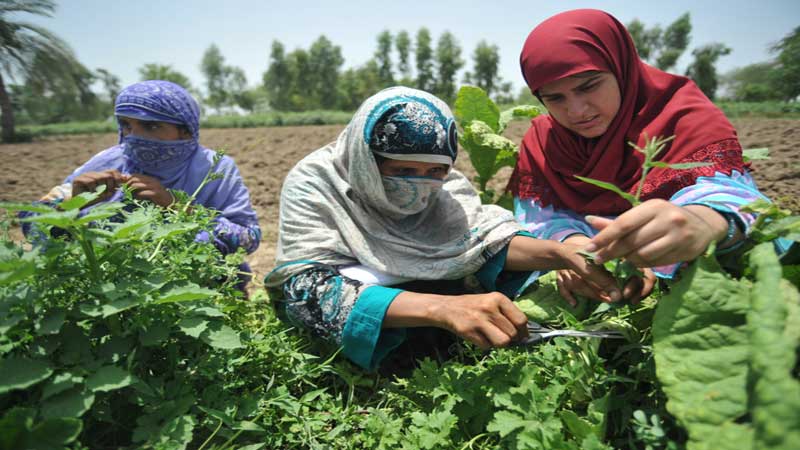60% of women working in agriculture fields remain unpaid


According to the report, the ratio of unpaid working ladies in agriculture is much higher than other sectors as 67 of them are engaged in agricultural work in different sections including 46 percent farming, 60 percent in livestock.
A 32 percent portion of women employment is in non-agricultural sector including small industry at homes, arts and other jobs, but the reward of such labour force to women is also zero, as per report.
Surprisingly, despite all claims from each government the women literacy rate could not be increased significantly as much as the authorities claimed.
As per the report, college education is a catalyst for women to enter into the formal, paid employment while only 3 percent rural women have college degrees and 57 percent of them are employed as primary teachers. The average wages of these women are Rs 16,000 per month.
The report stated that if comparisons are to be made, the number of unpaid working women in villages is more than the paid ones.
The report also stated that only one percent women are entrepreneurs in the country while 20 percent rural women are classified as own account workers. Support for microenterprises has also remained limited to low return skills and enterprises with average loan size of Rs 25,000 per woman which fails to accommodate more women.
It was highlighted in the report that the National Financial Inclusion Strategy has been launched with an aim to provide easy access to financial services to at least 50 percent of the adult population and 25 percent of adult women by 2020. Currently, however few women and especially rural women, have access to such services. Rural women are not prepared to cope with the changes resulting from urbanisation, climate change, environmental degradation and shocks and technological innovations.
It said that the returns to education can be higher in rural areas for women, given the inroads being made through technology and the creeping urbanisation where rural markets are no longer.
Unfortunately, rural women tend to have low literacy rates and gender disparities remain high.
The status of over overall literacy for rural women is also very low. As per report, the literacy rate among the rural women between the ages of 15-64 years is 35 percent while this ratio among the urban areas is 69 percent.
Moreover, the male literacy rate in rural parts is 63 percent which is almost double that of rural women and also questions the authorities who claimed to decrease gender parity in respect of education.
The UN Women recommended in the report that connectivity, education and skills training, value added work additions, land rights reproductive rights, freedom, threat of violence and China Pakistan Economic Corridor (CPEC) can be game changers for women, if they address their needs and policy actions are matched by resources and implementation.
It suggested that technology has the potential to change women’s lives drastically whether it is for easing domestic burden through labour saving devices, or improving agricultural work through tools and equipment.
Improving women’s access to agricultural inputs, using simple technologies to connect them to markets and information sources, expanding financial inclusion through mobile wallets and branchless banking, and removing conventional barriers to accessing credit such as collateral, male guarantors etc, adds value to women’s work.
Besides, it recommended that skills training, outreach and content, has to shift from its current focus on women’s reproductive roles and view them as major contributors to the economy. Trainings in value added outputs based on current work done by women, linkages to private sector investors and financial institution is needed.
Not only this, it suggested that climate change policy must be gender sensitive and nuanced to cater to the diverse geographic and topographic areas of Pakistan and the livelihoods of the communities therein.
“Strategies and action plans are needed to address the needs of rural women and they should be included in mitigation and adaptation strategies. Women should be involved at multiple levels of policy making and planning related to climate change,” the report said.
It was hoped that CPEC will connect rural populations and has the potential to improve rural women’s economic and social status, provided the planning at this stage is rigorous and evidence based with social and environment impact studies that assess the possibility and potential of change and the mitigation strategies for any adverse impacts.
Published in Daily Times, July 20th 2018.
Recent Posts
- Pakistan
Mobile internet services suspended again in Quetta
Mobile internet services have been suspended in Quetta, causing frustration for users across the city.…
- World
Netanyahu visits Hungary despite ICC arrest warrant
Israeli Prime Minister Benjamin Netanyahu will visit Hungary for four days. This is despite an…
- World
Myanmar earthquake death toll rises to 2,900, search efforts ongoing in Thailand
The death toll from the 7.7-magnitude earthquake that struck Myanmar on March 28 has risen…
- Pakistan
Punjab police officer SP Aisha Butt wins global excellence award
SP Aisha Butt, a Punjab Police officer, has been honored with the prestigious Excellence in…
- Pakistan
PM Shehbaz Set to Announce Rs8 Per Unit Power Tariff Reduction
Prime Minister Shehbaz Sharif is expected to announce a reduction in electricity prices during a…
- Sports
Pakistan faces 84-run defeat against New Zealand in second ODI
Pakistan lost to New Zealand by 84 runs in the second ODI of the three-match…
Leave a Comment